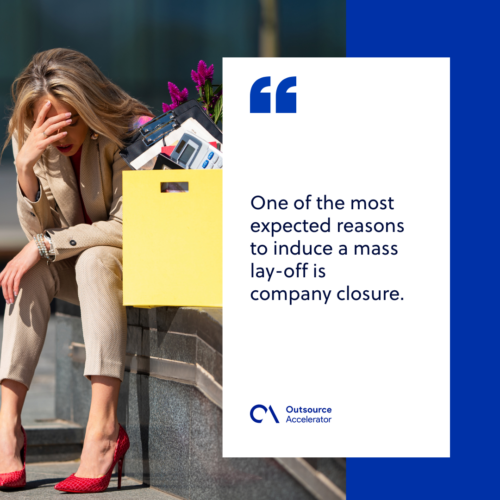Checking Out the Interplay In Between Business Redundancy and Business Versatility for Future Growth
In the vibrant landscape of today's company world, the detailed relationship between business redundancy and business adaptability arises as a crucial element for continual development and success. Companies typically encounter the challenge of striking a delicate balance in between keeping a degree of redundancy to mitigate risks and promoting versatility to react promptly to the ever-evolving market needs.
Importance of Business Redundancy
Business redundancy is a vital component that boosts business resilience and mitigates operational dangers. By integrating redundancy procedures within the business structure, business can better stand up to unpredicted disturbances and fluctuations in the company atmosphere. Redundancy works as a tactical buffer, enabling business to adapt and respond effectively to unanticipated obstacles without endangering essential operations.
One trick facet of the value of company redundancy is its role in making certain continuity throughout times of crisis. When confronted with abrupt adjustments or emergency situations, repetitive systems, resources, or personnel can tip in to preserve vital functions and avoid widespread disturbances. This continuity not only safeguards the firm's track record and client trust yet likewise reduces economic losses and functional downtime.

Methods for Business Flexibility

Another critical strategy is buying innovation and framework that can sustain flexibility and scalability. Executing electronic devices, automation, and information analytics can improve procedures, enhance effectiveness, and offer important understandings for educated decision-making. Additionally, creating versatile business frameworks that permit for quick adjustments to market dynamics and customer requirements is essential for remaining competitive in a swiftly evolving environment. By proactively identifying potential disruptions and opportunities, organizations can proactively flourish and adapt in an ever-changing business landscape.
Harmonizing Redundancy and Versatility
Attaining an unified equilibrium in between functional redundancy and organizational adaptability is extremely important in browsing the intricacies of a dynamic business setting. Redundancy within a business offers a safeguard, ensuring connection and stability in procedures. However, an unwanted of redundancy can result in inefficiencies and prevent versatility to transforming market conditions. On the various other hand, business adaptability permits companies to respond immediately to outside disturbances and take new chances. Striking the best equilibrium between redundancy and adaptability is a fragile procedure that Find Out More needs a deep understanding of the organization's objectives, industry dynamics, and threat tolerance.
To attain this balance, business need to carry out normal analyses of their procedures to recognize locations where redundancy is necessary for risk mitigation and where adaptability can drive innovation and growth. Carrying out adaptable frameworks, cultivating a society of continual understanding and renovation, and urging open interaction throughout all degrees of the company are vital methods to integrate redundancy and flexibility successfully. By lining up these two important aspects, business can position themselves for sustainable development and success in an ever-changing organization landscape.
Instance Studies on Adaptation Success
In analyzing instances of successful business adjustment, it ends up being apparent that the interplay in between operational redundancy and flexibility is a specifying aspect in shaping resilient organizations. One engaging study is that of Netflix. Originally a DVD rental service, Netflix demonstrated remarkable flexibility by transitioning into a streaming platform when digitalization interfered with the market. By tactically investing in modern technology and material creation, Netflix not just made it through yet prospered in a rapidly progressing market. An additional standout example is Amazon. Beginning as an on the internet bookstore, Amazon constantly adjusted its company model, broadening into diverse sectors such as cloud computer and expert system. This flexibility enabled Amazon to remain ahead of rivals and satisfy transforming consumer needs. Lastly, Adobe supplies a significant picture of effective adaptation. The firm shifted from selling software licenses to a subscription-based design, ensuring repeating earnings streams and enhanced client engagement. These study underscore the relevance of functional redundancy coupled with business flexibility in cultivating long-term growth and competitiveness.
Building Strength for Future Development
Structure durability for future development calls for a strategic alignment of functional procedures with market characteristics and arising patterns. Business need to adapt to altering environments by fostering a culture of flexibility, innovation, and continual pop over to this web-site renovation. Strength includes not only jumping back from troubles yet likewise proactively getting ready for future challenges. One key facet of structure durability is buying robust threat administration techniques to alleviate prospective disruptions. This consists of circumstance planning, diversifying supply chains, and creating contingency plans for numerous contingencies (who pays redundancy money).
In addition, promoting solid connections with stakeholders, such as consumers, workers, suppliers, and the neighborhood, is important for weathering unpredictabilities and maintaining trust fund and support throughout turbulent times. Efficient interaction and transparency play an essential role in structure strength, as they help line up assumptions and facilitate cooperation in navigating uncertainties.
Moreover, organizations need to focus on understanding and development efforts to upskill employees and furnish them with the necessary tools to adjust to altering conditions. By purchasing their workforce, companies can improve their flexibility and dexterity, ultimately strengthening their durability for lasting future development.
Verdict

In the dynamic landscape of today's organization world, the detailed connection in between company redundancy and organizational flexibility emerges as a critical factor for continual growth and success. Business often deal with the obstacle of striking a delicate equilibrium in between maintaining a degree of redundancy to minimize risks and promoting versatility to react quickly have a peek here to the ever-evolving market needs.To achieve this balance, business require to conduct routine analyses of their procedures to identify areas where redundancy is essential for threat mitigation and where adaptability can drive advancement and development.In conclusion, the interplay between firm redundancy and business adaptability is important for future development. Structure strength via a mix of redundancy and adaptability will guarantee that business are prepared for the obstacles of the future.
Comments on “Discussed: If a Company Goes Bust Who Pays Redundancy in the UK?”